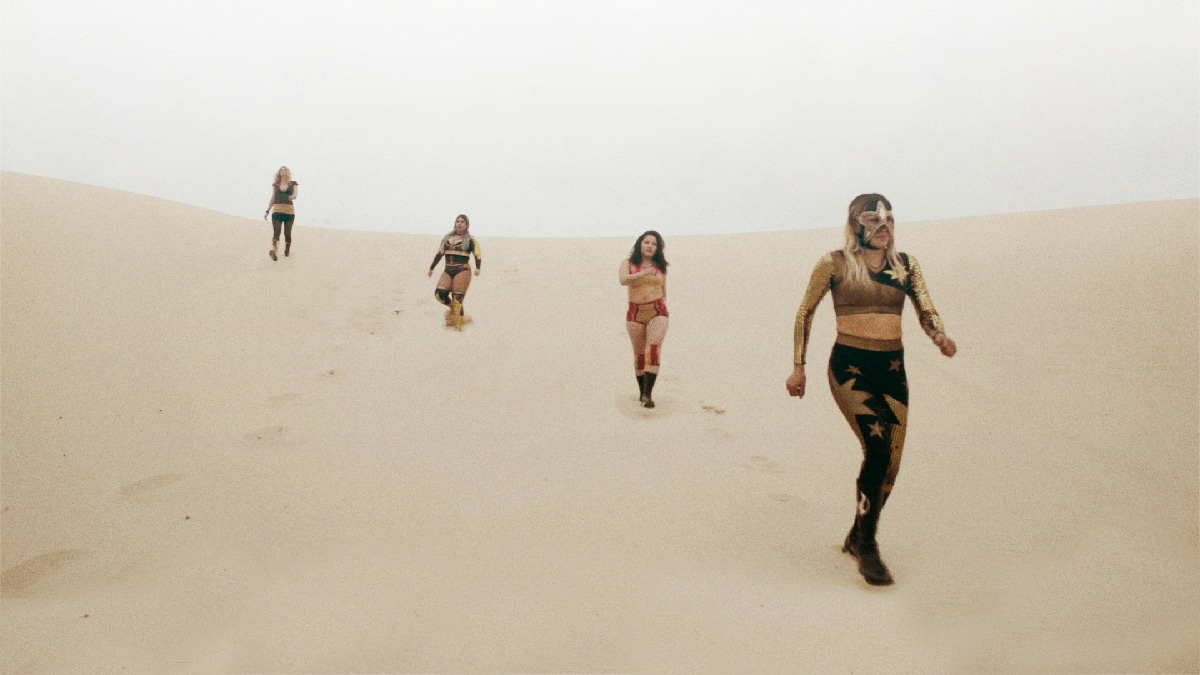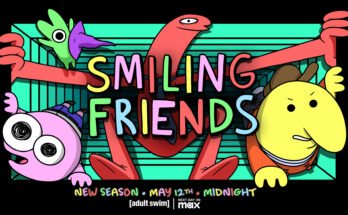Want to hear more from the actors and creators of your favorite shows and films? Subscribe to The Cinema Spot on YouTube for all of our upcoming interviews!
Managing editor & film and television critic with a Bachelor's of Arts in English Literature with a Writing Minor from the University of Guam. Currently in graduate school completing a Master's in English Literature.
My interview with the co-director, Paola Calvo, took place on Tuesday, March 16th at 1:00 pm Central European Time. Her documentary, Luchadoras, premiered at the South by Southwest (SXSW) film festival that same week. (Co-director Patrick Jasim was out of town and unable to make it to the Zoom meeting.) The following article presented here is Calvo’s 27-minute conversation with The Cinema Spot during SXSW.
Trigger warning ahead for those who have been in toxic environments and areas of violence.
Introductions
JT: Hi, Paola. My name is John Daniel Tangalin, and I’m a film and television critic for The Cinema Spot. I just want to let you know that I have seen Luchadoras, or is it Las? Because one of the posters said Las Luchadoras, right?
PC: Luchadoras. Yeah, that’s right. That’s the name of the film.
JT: Okay. I’ve seen your feature documentary and … wow, it’s really great. How would you describe the plot of your documentary?
PC: Well, Luchadoras is a film about courageous women in Ciudad Juárez, who not only fight in the ring but also in their daily lives to give a new image of what it means to be women in Mexico.
The Importance of Lucha Libre
JT: How important is this sport of wrestling or fighting in Mexico?
PC: Well, in Mexico, … wrestling is called lucha libre. It’s quite big and … I will say that from my experience, from what I experienced there is that it’s even more popular than fútbol [soccer] because it connects all parts of the family. Like the children wants to go there with their moms, with their sisters, with their fathers, with the neighbors, like everybody is [at] the fights, watching the fights. It’s for everyone, it’s super accessible. I mean, there are different leagues of lucha libre, of course, and there are like the high ones with the big stadiums and with the big stars. Then there are the other more underground [ones] … [A]t least in Juárez, it felt super, super popular, and everybody was going to the luchas. I did not know somebody who would not go to the lucha libre.
How Lucha Libre Can Be More Important Than Even Fútbol
JT: Since you bring up that it’s popular more popular than fútbol, or at least in American society, it’s called soccer. At least from Western media, it’s [lucha libre] not given much representation. How does it feel or what is it like to put the sport of wrestling or fighting in the spotlight?
PC: [F]or us it was also like a big surprise to know that lucha libre was so big. We didn’t know that before we began to do the film. Yeah … lucha libre is so powerful. [T]he people, when they jump in the ring, they do crazy stuff. They jump, they fly, they’re like real superheroes made out of bones and flesh, you know? You can touch them, you can be with them, you can chat with them. After the fights, you go and you take your selfie. [O]f course the children look at them and they want to be like the luchadoras. It’s a very, very, very interesting context where a lot of energies and a lot of potential shows up. Of course, we are super happy that we discovered that and that we could put it into the film. It has so much power. The wrestlers/ luchadoras are, like I said, real superheroes made out of bone and flesh.
JT: That’s a great answer because I love that you can have someone who’s fighting for you. Especially with the plot, with the story of your film, … these are real people and real stories that they’re actually going through. A trial and tribulation, so to speak.
Themes and Concepts of the Documentary
JT, con’t.: What are some themes that are present in your documentary?
PC: When we went to Juarez and we met our protagonist, we were so blown away [with] the contrast of what it really was to be a woman in Cuidad Juárez, because what you hear from Cuidad Juárez is normally you hear about all this violence, horrible violence against women, and about all these horrible things that people do with women there [as a result of] this horrible machismo. Then we were so happy and so inspired when we met our protagonists, and we realized, “Okay, it’s not at all like that.”
There are a lot of people … a lot of women who are super powerful, super strong, and they are totally the opposite of what you think Cuidad Juárez is before you go there. It was, from the beginning, very important to have this contrast of — “Okay, this is what you hear about Juárez, but this is actually what it is.” Women are super powerful, and women are not victims. Women go to the streets and say, “[We’ve had] enough of machismo.” This will be [the] main theme that we would like to go with.
The Presence of Men in Mexican Women’s Lives
PC, con’t.: [A]t the same time, with shooting it was very interesting to realize that you could feel this machismo is really in the daily life of all of the protagonists. There are little comments and little things. When Mini Sirenita is making her hair, and then [a] friend asked her, “Yeah, why didn’t you want to have a husband?” [She responds with] “Well, because my husband will hit me. And if somebody wants to hit me, then I’m better as a luchadora, so I get money for that,” you know? These kinds of ideas. Suddenly, you realize the machismo is everywhere. We weren’t looking for it, but it was there, present with every one of the protagonists. It was there.
Also, not only that but also the humor they take with that. Those women, they’re amazing because they manage [and] even see the reality, which is super hard and it’s super harsh, then make a joke. [B]ecause you’re making a joke … you being super strong at the same time. So yeah, I would say machismo humor was also a very important topic that came while making [the documentary]. We didn’t know it worked, we didn’t know that these women were so humorful and were so powerful in this context. Then another topic, of course, motherhood was super important that it was something that we discovered by the way. So yeah, I would say those were the main [themes].
The Presence of Food
PC, con’t.: And the food! [The luchadoras] love to eat, but this is not in the movie, really. We have little moments. There’s this moment where Mini Sirenita is outside of the arena, eating some burrito. We don’t have [many appearances of food in the film]. We were so hungry, we were super hungry and we were like, “Okay, we need something to eat. Okay. Okay.” And she was super tense, “I have to sit down and eat. No worries. Let’s eat.” And then we thought, “[T]hat’s a nice shot,” so that’s the shot. So yeah, it’s a burrito, it’s a big burrito and [a] super nice burrito.
JT: Well I also noticed that Baby Star — she had a Popsicle or some dessert treat that she was eating, and she was with her daughter. That’s another food. What was that?
PC: Yeah, you’re right. She’s in the car with her husband or [ex-husband] and they’re eating ice cream. You’re right. You’re right. [It’s] ice cream you’re right. Yes. Yes.
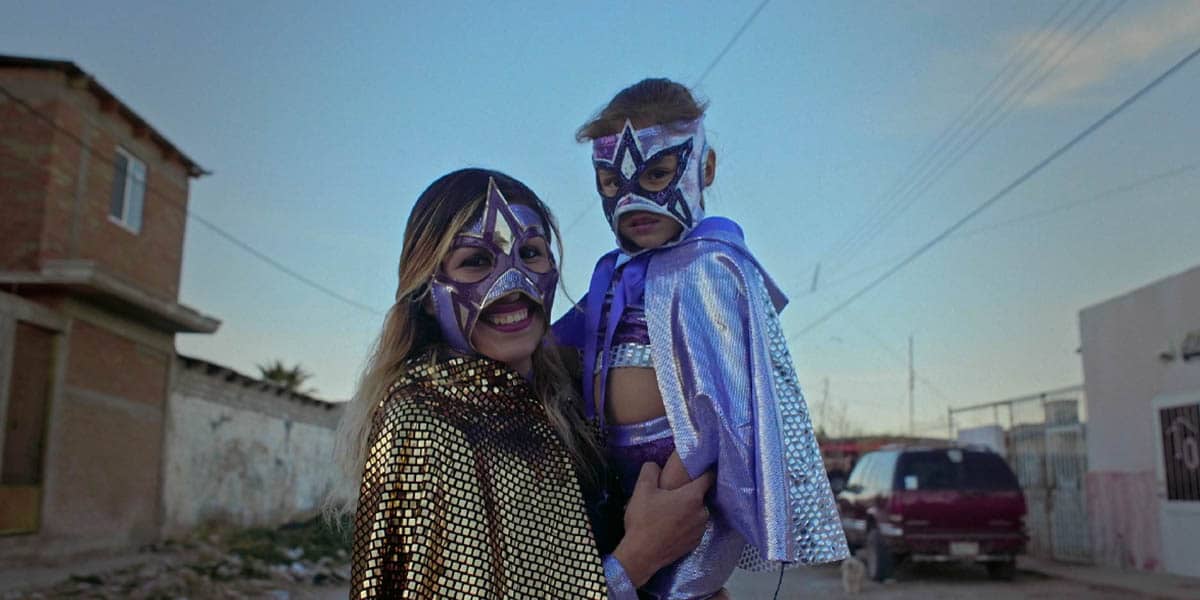
Masks
JT: Baby Star wears a mask of her own, and she has her reasons to wear it. Can we say that [Lady] Candy and maybe Mini Sirenita wear figurative or literal masks of their own?
PC: Well, that’s a nice question. I have to say the way I experienced both, they were both very open and very clear. I don’t think they wear a mask. And even though Baby Star is wearing a mask, I think the only reason why she can work as a protagonist in the film is [that] she’s super honest in the way she acts. Even though you cannot see her face, you understand who is the woman behind the mask. And I think that’s because at the beginning we were very, let’s say, concerned about the idea. “Okay, we’re going to have a protagonist and you’re not going to see her face. Is it going to work?”
Because normally you have superhero films and at some point, they take off the mask. You see their faces. Even from the bad guy at the end, you see the face of the bad guy. In this case, it was clear we were never gonna show her face, so is it gonna work? And we didn’t know. We were shooting [the documentary] and had no idea if the character of Baby Star was gonna make it to the film, but it did. She’s wearing a mask, but all of them … are very honest [about] who they are and to what they want in life. It’s a very beautiful question, John, actually.
The Appearance of Other Luchadoras
JT: Are the[re] three women? You have Baby Star and Mini Sirenita and Candy. Those are the three women, but on the [film] poster you have four. Is that Little Star, which is the sister of a Baby Star?
PC: You’re such a good detective, man. That’s so nice.
JT: Well, I think at the same time, Little Star isn’t featured as much until maybe halfway through the film. Are these women connected in any way? Maybe by story, like they have a similar story, or aside from the fact that they’re women?
PC: No. I mean, like at the beginning, we did not only shoot with Baby, Candy, and Mini. We had a lot of other luchadoras we were shooting with. [Paola Calvo names some female wrestlers], Little Star. [In] the picture we have in the poster, there are other luchadoras we were shooting also with. That’s what the end [of the film] didn’t manage to do.
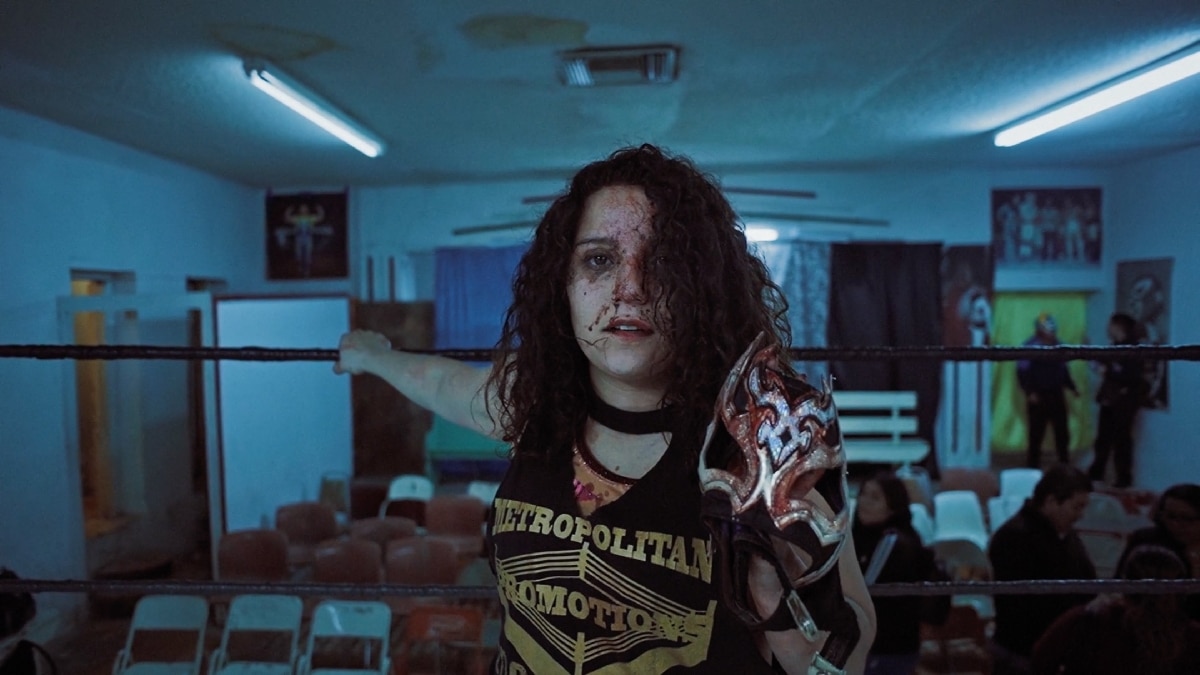
What the Film’s Luchadoras Mean to the Story
PC, cont.: [F]or us, it still represents a lot of the movie, even though there are other women in the poster. There are women who we really admire and who we really think their fight is super strong in the ring and in the streets because that’s the thing [about] this film. Yeah, it’s nice. You’re a very, very, very good detective.
Mini Sirenita and Little Star are not on the poster, but it still feels like [they are] there, like it’s the four of them. It’s not only the four of them. Actually, the fight is a bigger fight, it’s a collective fight. It’s not only these four or three women you have in the film but also it’s a representation of a movement. That’s actually the reason why the film was making a representation of a movement, which is super powerful right now. The feminist movement in Latin America is super, super, super strong. That’s why for us it was not that important if it’s her or the other. It’s just this group of women coming down the hill saying, “We’re here and we’re here to help.”
I will note here that the poster being discussed can be seen at the top of this article.
Women Using Lucha Libre as Self-Defense
JT: I love that. As you show in your film, women’s lives are put at risk every day in Mexico. And in your documentary, there’s one scene that shows that the luchadoras [are] teaching other women to fight for themselves Aside from [this], are there other ways to make this issue known; to spread [the] word about this issue that there’s violence against women?
PC: Well, you know violence against women happens because of the structure we’ll live in. We live in a structure, which is based in machismo. Machismo means that men feel superior to women. And because that happens, this generates a lot of different consequences in the way society treats women. The thing is that the base of where it all began, it’s [a] very, very, very long time ago.
The Disparities Between Men and Women
PC, con’t.: You know, there was a moment where men and women will work. The woman will be working at home. The men will be working outside the home, and they will get paid for both of the jobs. Well, there was this fatalism in the middle age, but at some point, [the] money arrived in the system. Then, the only work which was paid was the work of the men. [T]his decision … meant only the work of the man is evaluated, and only the work of the man is getting paid. The women stay at home and they do the same work they did before, but they don’t get paid. They [the women] have children and they take care of their home and they tell it in it. And all these things put in the system that we live in, I think that’s super simple. That’s the base of the idea that women’s actions and women’s words are less valued than men’s words.
Debunking Sexual Stereotypes
PC, con’t.: This is the thing that we have to really be aware of. It is not that the women’s genes are made for being in the kitchen. No, it is something we learned culturally. It is a structure that we built up ourselves in the system we live in. And it has a lot, a lot, a lot of years of background. We have to stop this, we have to stop these beliefs. We have to be aware of what we are and how we are and why we manage to be here as we are and begin to break it.
And the killing of the woman is just the point of an iceberg of a very, very, very big problem. This happens because there are a lot of theories saying… Well, women are now being independent. Women are now getting, not only now. It happened already a lot, but now it’s getting bigger. Women are getting their [way]. They’re being financially independent [of] other people. This is generating a lot of callous in the minds of a lot of people who cannot deal with the idea.
Men As the Bringers of Violence
PC, con’t.: “Does it mean I’m not a good man if my woman is bringing the money home and I’m staying at home?” This question look[s] so simple, [and yet men are] generating all this violence, and it’s horrible. I mean, sorry, I can talk for hours. We have the violence, we have domestic violence.
First, you have the domestic at home, the violence at home. You have a partner who thinks, and it’s also sa[id] in the film, “You have to stay home. You have to take care of the children. I’m going to make the money.” No, this doesn’t have to be like this. This can be changed, but that’s the base. And if this doesn’t happen, the man has the power — or feels he has the power — to dominate the situation. Then, the woman goes out from home. And if she wants to say, “Hey, I’m experiencing some violence,” people are going to [ask],”Hmm, are you sure it’s not your fault?”
JT: They do say that in the film.
Victim Blaming
PC: Yeah. That’s the thing. [For example], a woman gets raped and the first thing you do is to say, “Hmm, probably her skirt was too short.” That’s the thoughts in the minds of the people, and this is bad. This is really bad, and we have to be aware of this. We cannot think that. Of course, your family [might] say, “Don’t put [on] a short skirt just to protect yourself” —
JT: That doesn’t do anything.
PC: That is not a reason to get raped. This way of thinking, it’s really in the minds of a lot of people, like a lot of people.
Living in (and Taking Down) the System
PC, con’t.: And I have to say, for my space, I have a twin brother. My mom and my dad, we would grow up together and they say, “Girls and boys are the same.” I went to a film school where it was super progressive and we were the same girls and boys in the cinematography class — because I started from photography. So I was very protected from the beginning. Then, I left the school and I was like, “Okay, what is going on?” I began to realize it was very late for me. I realized this, I don’t know, six years ago when I began to realize what is happening. Women are just so … abused [by] the system. It’s so unfair and we have to be aware of that. We have to be aware of these structures that are killing us.
And really, I think the system we live in, they are killing women. They are killing — it’s super restless. They’re killing our people. Not [just] the white men. And we are killing the planet. We can’t, we have to change. We have to change that, and that’s what I was saying. The feminist movement in Latin America is super strong because it’s defending exactly that. We have to take care of the world. We have to go back to our roots and be aware and finish this machismo situation worldwide because it happens all around the world.
The Patriarch
JT: Yeah. I agree with you that this is a patriarchal view of [perceiving] women, that they should be dominated. That’s wrong. We’re in a new century now and still, people have thought this for even decades and decades and centuries. That needs to be rethought and squashed, that view that there should be violence against them [that is, women]. Unfortunately, it happens in many other countries. [W]hat your documentary does is an excellent achievement at bringing this to the view of the audience, so thank you for that.
I had one last question for this interview because I did not know how long I was supposed to take.
Challenges in Filming
JT, con’t.: Your co-director, Patrick Jasim, … does great camera work in your film. What was the toughest part about filming your project?
PC: I’m going to tell him that, what you’re saying. He’s going to be very happy after you said that. Well, when we had the idea of making the film in [Ciudad] Juárez, we developed a kind of visual concept, but we didn’t know if this was going to be possible because we didn’t know the city. We knew the city was very dangerous. One of the most difficult things [about] making the film was shooting in Juárez. [I]t’s a very dangerous place, and you know, danger is always connected with fear.
Learning Through Social Behavior
PC, con’t.: Maybe you were not in a dangerous situation, but you’re afraid and you don’t feel secure. This affects the way you treat the people and the way you connect with the people around you. It was a very intense learning process to deal with all these feelings. But we also learned from our protagonists — from the people we met — that they live along this [she is trying to find the words] kind of social behavior.
The people from there … behave differently. There are some rules that you learn when you’re there, how you should do and how you should not do it. For us, it was also very good that we were always in groups, we’re always with people. Then we learned, this is actually one of the ways to be safe, to be part of a group and try as less as possible to be alone on your own in the streets. This was one of the big things that we learned. We were always in groups, we were always like a couple of people doing stuff. But it was hard. It was very hard.
Luchadoras Sharing Their Power with the Filmmakers
PC, con’t.: Even though it was such a hard context, Patrick did manage to make a wonderful job. It [i]s super nice, the way the protagonists allowed us to get so close to them and to do this way of very close cinematography. Like real life, getting to understand and to know who those people are. It was also like a balance because even though we were afraid, a lot of times they give us the power back so we could feel secure.
So it was a kind of a [I cannot make this word or phrase out] situation, which makes the work there very, very interesting. Juárez it’s a place full of contrast, a very complicated place. There are a lot of really bad things happening, but there are a lot of incredible people fighting for a change. I’m not only talking about the luchadoras or the feminists. Really, there are a lot of people who are thinking and they’re trying to approach each other in a warm and lovely way, even though the place is so dangerous. So it’s a very, very, very interesting place.
Two Sides to the Coin
JT: I think that’s a good thing that you bring up. The duality; like there [are] two sides to a coin. Even where I live it’s — because I live in the Pacific region of the world and I live on an island. When you think of an island, it’s beautiful, right? There is a lot of forest or jungles, coconuts, and the people are good. But then like what you said about Juarez, right?
You know, just because it looks beautiful, you cannot neglect [it], you cannot ignore the bad side about it because it’s not always good. You need to also remember that there [are] also pros and cons to everything. I think that it’s great that you talk about and discuss that throughout your film. Thank you so much for having this discussion about the women and [overall] your film. I look forward to just seeing your film again during this festival, so thank you, Paola.
PC: Thank you. Thank you so much.
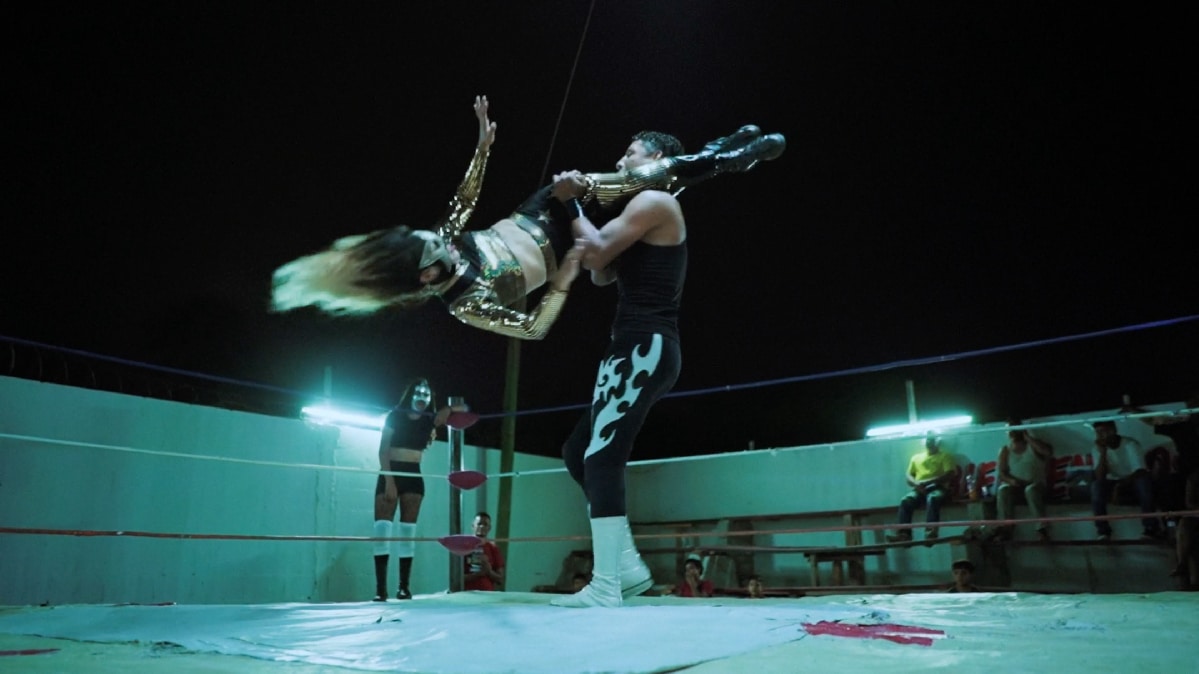
For more drama and documentary-related news and reviews, follow The Cinema Spot on Twitter (@TheCinemaSpot) and Instagram (@thecinemaspot_). Also, you can now find us on Facebook (TheCinemaSpotFB)!
Also, take a look at our review of Luchadoras!
Managing editor & film and television critic with a Bachelor's of Arts in English Literature with a Writing Minor from the University of Guam. Currently in graduate school completing a Master's in English Literature.


